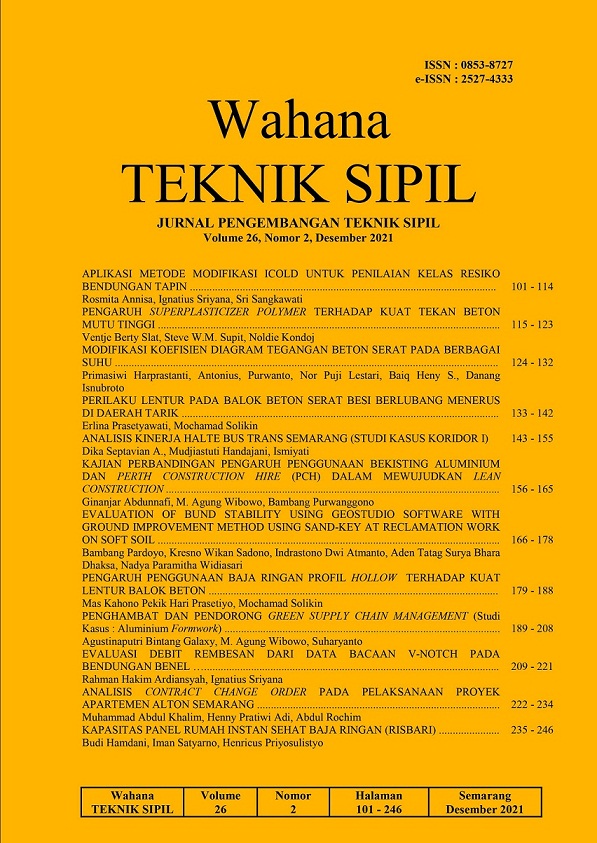PENGHAMBAT DAN PENDORONG GREEN SUPPLY CHAIN MANAGEMENT (Studi Kasus : Aluminium Formwork)
DOI:
https://doi.org/10.32497/wahanats.v26i2.3133Keywords:
Construction Project, GSCM, Aluminum FormworkAbstract
Technological innovation in the construction sector is needed not only aimed at faster construction but also environmentally friendly. Engineering the formwork system using aluminum is one of the technological innovations to accelerate development and adopt the 3R (Reuse, Reduce, and Recycle) concept. To support the use of aluminum formwork, an environmentally friendly supply chain activity management model is needed. The Green Supply Chain Management (GSCM) approach is one method that can reduce waste. This study analyzes the driving and inhibiting factors of GSCM using aluminum formwork in an apartment project in Semarang. The method of compiling this research used a qualitative method, where interviews were conducted which were then made into complete transcripts and grouped each opinion with a SWOT matrix approach. Based on the results of the SWOT analysis, 4 factors have a significant effect. Among these 4 factors, there are 2 driving factors, namely government regulations regarding environmental protection and commitment to protecting the environment, and 2 inhibiting factors, namely the availability of suppliers who implement GSCM practices in construction areas and require careful planning. The use of aluminum formwork can save costs up to 5.44% with a construction time of 6 days faster than conventional methods.References
Adetunji, I., Price, A., & Fleming, P., 2008, Achieving sustainability in the construction supply chain, Engineering Sustainability, vol. 161, pp 421-426.
BRE, 2003, Construction site transport. Retrieved from BRE : www.bre.co.uk/pdf/construction traffic.pdf Briscoe, G., Dainty, A.R.
Ghobakhloo, M., Tang, S.H., Zulkifli, N., & Ariffin , M. K, 2013, An integrated framework of green supply chain management implementation, International Journal of Innovation, Management and Technology, vol. 4 no. 1, pp 86.
Glavinich, T.E., 2008, Contractor's Guide to Green Building Construction, New Jersey : John Wiley.
Hermawan, F., 2014, Kapabilitas Dinamik Sektor Konstruksi Gedung Di Daerah Menuju Keberlanjutan Pembangunan Yang Realistis : Pendekatan Studi Kasus Kegagalan Konstruksi dan Bangunan Di Jawa, ResearchGate, pp 1-8.
Hsu, C., & Hu, A., 2008, Green supply chain management in the electronic industry, International Journal of Environment Science and Technology, vol. 5, pp 205-216.
Liu, J., Low, S., & He, X., 2012, Green practices in the Chinese building industry: drivers and impediments, Journal of Technology Management in China, vol.7, pp 50-63.
Mudzakir, A.C., Setiawan, A., Wibowo, M.A., Khasani, R.R., 2017, Evaluasi Waste dan Implementasi Lean Construction (Studi Kasus : Proyek Pembangunan Gedung Serbaguna Taruna Politeknik Ilmu Pelayaran Semarang), Jurnal Karya Teknik Sipil, vol. 6, pp 145 - 158.
Ofori, G., Gang, G., Briffett, C., 2000, Impact of ISO 14000 on construction enterprises in Singapore, Construction Management and Economics, vol.18, pp 935-947.
Rahardjo, M., 2017, Studi Kasus Dalam Penelitian Kualitatif : Konsep dan Prosedurnya, Malang: Universitas Islam Negeri Maulana Malik Ibrahim Malang.
Republik Indonesia, 2012, Peraturan Pemerintah Republik Indonesia Nomor 27 tahun 2012 Tentang Izin Lingkungan. Lembaran Negara RI Tahun 2012, No. 5285. Sekretariat Negara. Jakarta.
Robin, C., Poon, C., 2009, Cultural shift towards sustainability in the construction industry of Hong Kong, Journal of Environmental Management, vol. 90, pp 3616-3628.
Shen, L., Tan, W., 2002, Implementation of environmental management in the Hong Kong construction industry, International Journal of Project Management, vol. 20, pp 535-543.
Subdirektorat Statistik Konstruksi. 2021. Indikator Konstruksi, Triwulan III-2020. BPS - Statistics Indonesia, Jakarta. 86 hal.
Walker, H., & Jones, N., 2012, Sustainable supply chain management across the UK private sector, Supply Chain Management: An International Journal , vol. 17, pp 15-28.
Yahya, K., Boussabaine , A.H., 2004, Eco-costs of Sustainable Construction Waste Management. Proceedings of the 4th International Postgraduate Research Conference, pp 42-50.
Zhang, J., 2010, Research on the Building of Green Logistics System and the Development Strategy in Jilin Province. International Conference, Logistics engineering and management.
Zhang, X., Shen, L., & Wu, Y., 2011, Green strategy for gaining competitive advantage in housing development: a China study, Journal of Cleaner Production, vol. 19, pp 157-167.
Zhu, Q., Sarkis, J., Lai, K., 2007, Green supply management: pressures, practices and performance within the Chinese automobile industry, Journal of Cleaner Production, vol. 15, 449-468.
Downloads
Published
Issue
Section
License
Authors who publish with this journal agree to the following terms:Authors retain copyright and grant the journal right of first publication with the work simultaneously licensed under a Creative Commons Attribution License that allows others to share the work with an acknowledgement of the work's authorship and initial publication in this journal.
Authors are able to enter into separate, additional contractual arrangements for the non-exclusive distribution of the journal's published version of the work (e.g., post it to an institutional repository or publish it in a book), with an acknowledgement of its initial publication in this journal.
Authors are permitted and encouraged to post their work online (e.g., in institutional repositories or on their website) prior to and during the submission process, as it can lead to productive exchanges, as well as earlier and greater citation of published work (See The Effect of Open Access).






